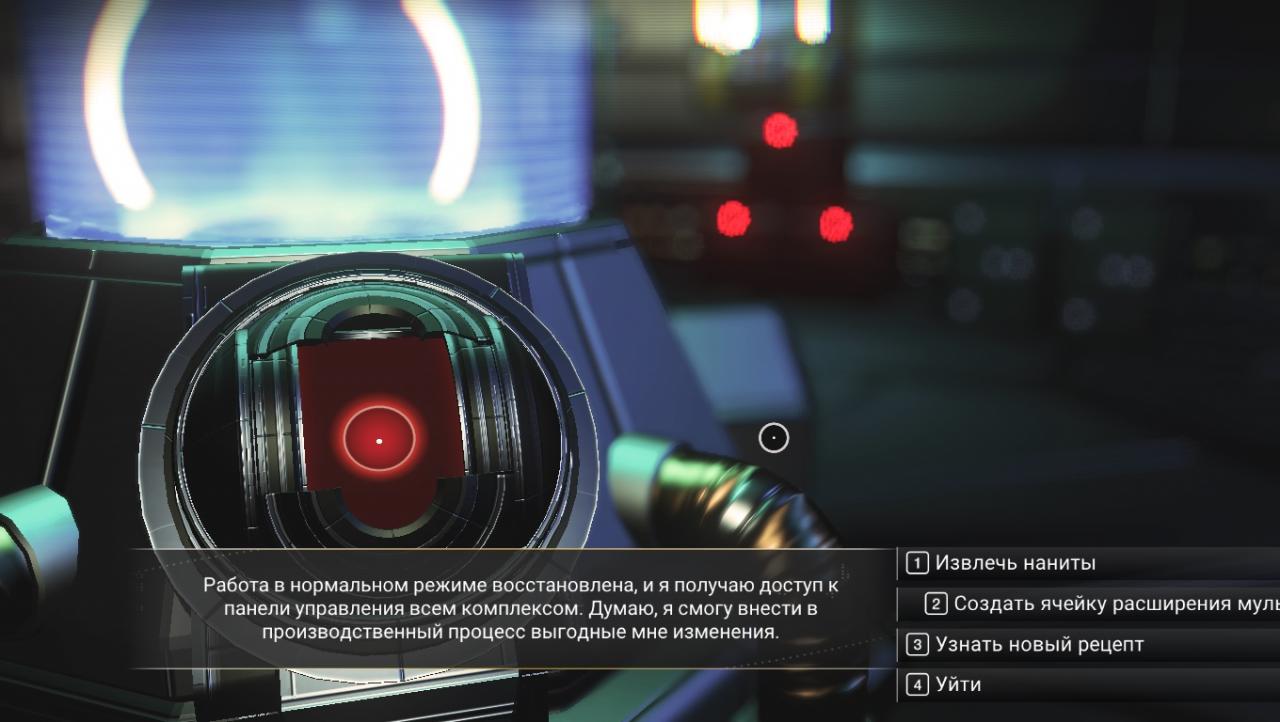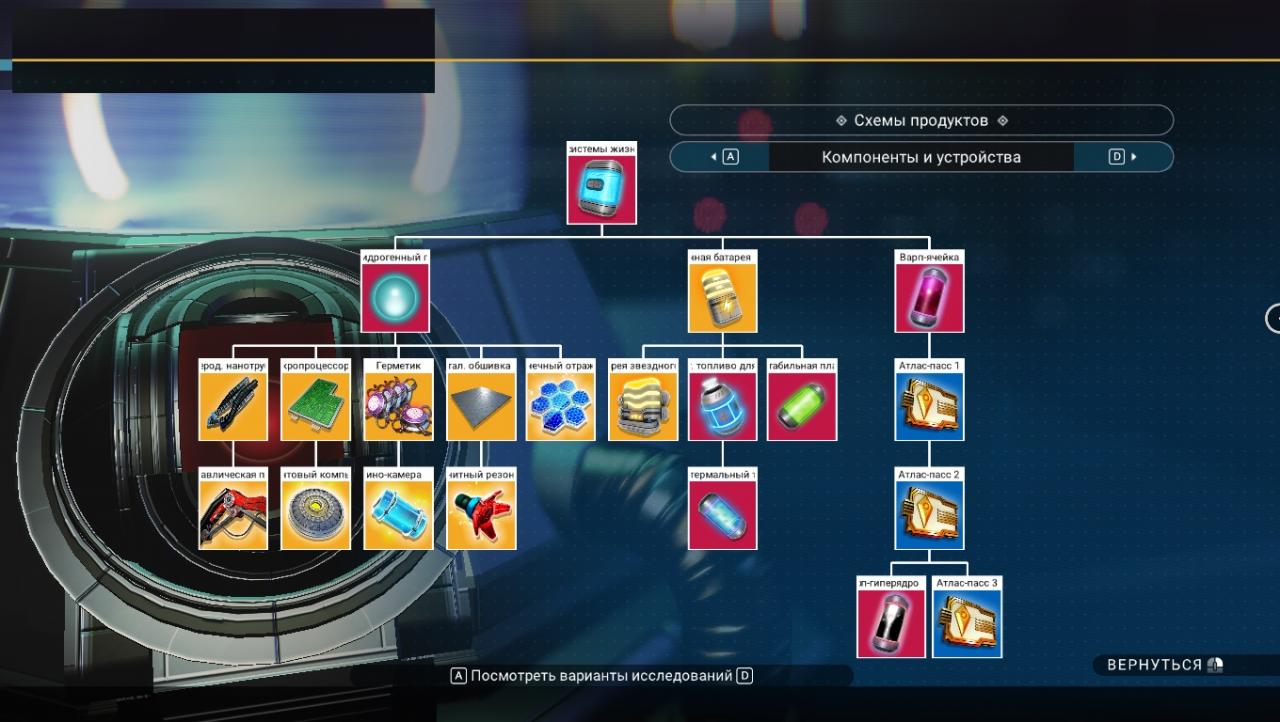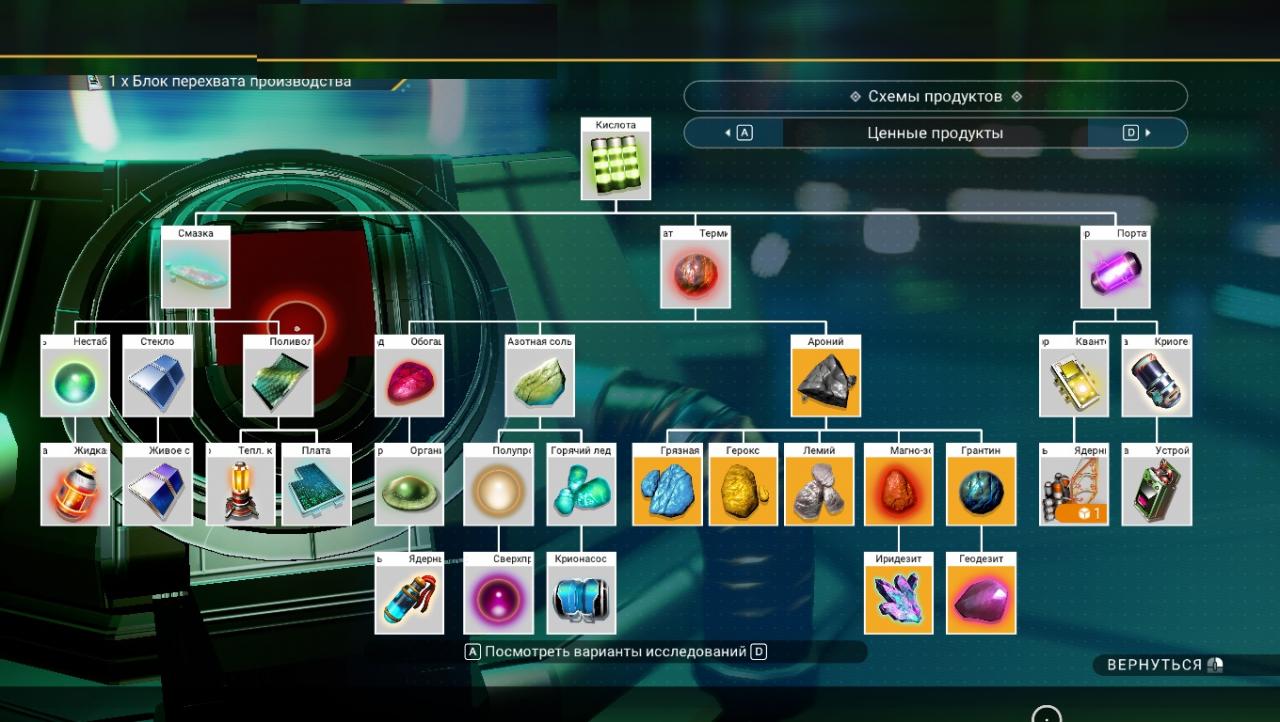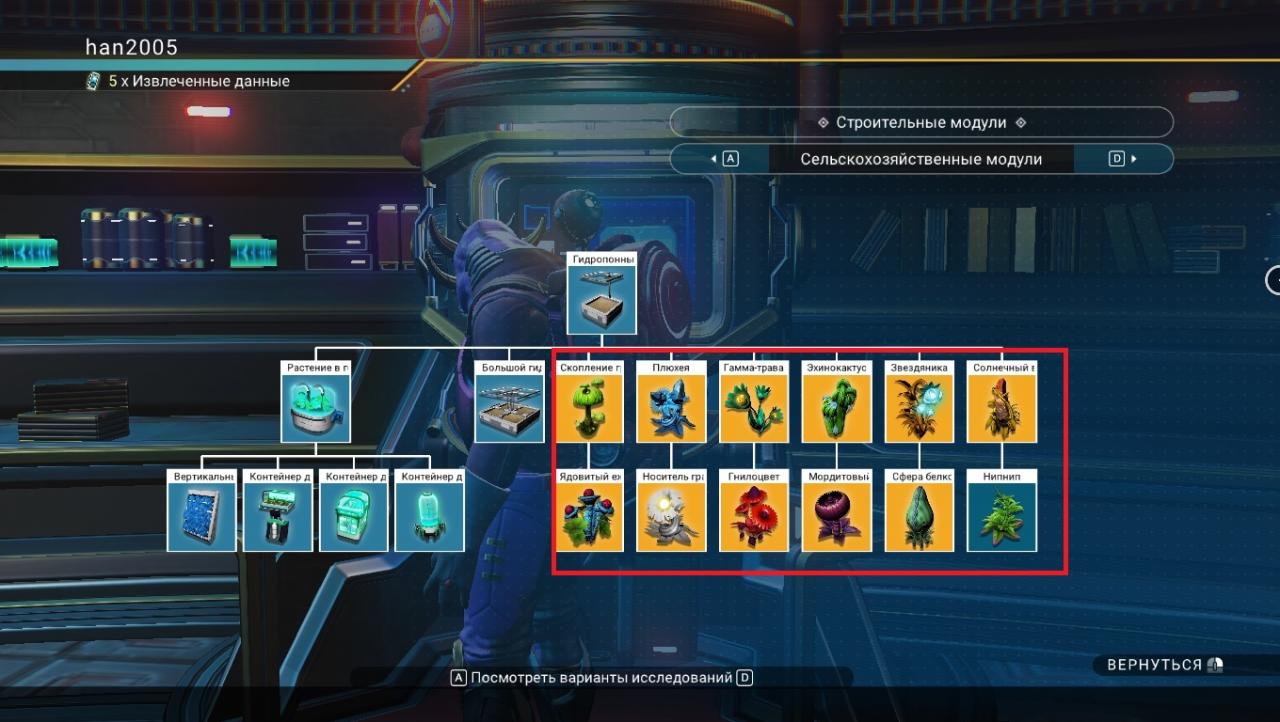
Initially, I thought of a guide only for the production of goods, ie. production schemes unlocked through factories, but then expanded, adding resource description
1. Introduction
In general, there are no problems with earning units in the NMS, any activity generates income. Elementary scanning, if you put 3 S class module per scanner, then a new kind of animal will bring 240000 young. Ie. just land on an unknown planet, scan without leaving the place 4-5 animals and a million in your pocket. This is certainly not the main way to make money., but nonetheless.
Activities in the NMS. Not rated by profitability, but just a list:
– archeology. Archaeological finds are highly variable in value. There are ordinary, rare and unique. Archeology can be divided into finding bones, scrap, and excavation sites.
Bones come before 6 pieces in one field, common average 70000, rare 200-300 thous. young, unique can up to a million.
Scrap in one place – one find, worth the usual 200-300 thous., rare 600-800, unique can be several million.
Excavation sites. Unlike the previous paragraphs, no need to look for a special planet, you can dig at any. We collect navigation data, at the station at the cartographer's place we change to maps of alien artifacts, we fly to the stove, select the second item “Find alien knowledge”. Next, we fly to the excavation site there, first we dig 3 key “Fragments in the artifact” and then a large box of artifacts. the cost of an ordinary art 200-300 thous, rare 700-800, unique may be 4-5 million. Also there you can collect 3 gravitational balls,2 the last one was buried at the top of the inclined platform, but raising balls will give you immediate alarm 3 level with the guards. The balls stand by 40000 young, ie. yet 120 thous on top.
I recommend archeology at the initial stage, since he has a low training threshold with a decent income. All you need is an analyzing visor and a landscape manipulator. Optional, signal amplifier, to collect navigation data. Optional, you can do without navigation maps, use an all-terrain vehicle scanner, for this you need to open the platform of the all-terrain vehicle on Anomaly, dual gain all-terrain vehicle scanner, and accordingly build all this. These technologies are unlocked by quests, but at the very end of the base extension line.
– Search for curiosities. Looks like archeology, but curiosities have fixed prices. I advise you to consider Storm Crystals, gravity balls and maybe the eggs of the abyss. Storm crystals gather on extreme planets during a storm. An extreme planet in space can be identified by the presence of an activated version of the metal (copper, cadmium, emeryl, indium).It is recommended to use an all-terrain vehicle with protection from harmful factors, but no one forbids buying at the station or crafting several hundred batteries or several thousand sodium and just walking in a spacesuit, constantly recharging. It is recommended to improve the suit: shield, motion system, life support system. In addition to harmful factors, the danger can be from weather conditions, once died just leaving an all-terrain vehicle, the whirlwind lifted it up into the sky, twisted it a little and slammed it on the ground. Can be struck by lightning. Safe for an upgraded exoskeleton, but at the start it can be fatal. Storm crystals meet in bundles up to 5, is worth 126 thousand yun. one thing.
Gravity balls. To find them, you need a planet with the inscription Aggressive Guardians. Further, everything is simple, we land, and collect balls while running from the guards. Sharikov deposits are scattered quite often, in one deposit they can be 5-7. Ball raising is alarming 3 level – this is a dog and flyers. fighting the guards is not recommended, if you raise the alarm before 4 level will come the walking guard. is worth 1 ball 40 thous. young. Survival gathers in stacks of 5 units, so it is recommended to clear the inventory to the maximum. If the suit is starting, it is not recommended to go far from the starship. If you feel, that smells very fried, you can bury yourself underground and wait there.
Collecting alien eggs. a pumped-over shield on the suit is required. Finding an abandoned building. we break the egg of strangers with a splitter or weapon. Quickly pick up the dropped Abyssal Egg. Next, have fun with the creatures. The egg needs to be picked up quickly, the creatures crawl out right from under your feet and push them away from the egg. Then you can repeat the operation with other eggs on the run. The egg is worth 68 thous. young. The main advice, do not stand still, do not hit the ramming jump, but mostly the creatures are not dangerous. Swarm critters count towards the creature kill quest, so you can collect quests at the station before this.
There is also a safe way to collect curiosities. Place the base computer and surround the resource place with walls and a roof, in which case it will be possible to collect these resources every day, and no environmental conditions, no guards will hurt you. But that's not interesting.
Other curiosities: protein pearl, vortex cubes, etc. are cheap. It's safe to collect them, but the time spent is not worth it.
– Combat with planetary guardians. This is mostly scarecrow prey, which can be processed into nanites. But the walking guard's brain is 40000 young. and the component of the four-legged guardians is 26000. Profitability is low, but if tired of the meditative walkthrough for a change, you can also recycle the guards into scrap metal.
– Space battles, pirate reward. In addition to the reward itself, alloys of the first level drop. Secondary earnings.
– Fight in space, piracy. From cargo ships, modules are most often needed to unlock technologies. Secondary, materials for construction: magnetized ferrite, ionized cobalt, gold, platinum. But if these materials are sold, you can earn a pretty penny. I thought at the beginning, that it is not worth doing this, but then I saw, What's on 8 the level of the guild of the mercenaries gives the quest to attack the cargo ships. the main thing, do not destroy individual capsules, lose your reputation. But for the attack of the ship itself and the accompanying frigates, the reputation does not fall.
– Quests. Here division: quests at the station, initial cheap, for good earnings, you need to raise your reputation at least to a level 6. And quests on Anomaly, there is no dependence on reputation, you can get it right from the start 400 thous. units, but you need to choose the quests that you can do. My favorites are the pirate hunt, executed quickly, and digging bones – takes longer, but besides the reward, the bones also remain. That exceed the reward.
– warehouses. Complex of 5 resource containers, guarded by guards. You can find either with the help of maps of protected objects, obtained from the cartographer at the station, or an all-terrain vehicle scanner (no improvements required).
– Search for damaged starships for analysis. Changing navigation data to alarm maps at the cartographer. And we fly over them. Unit profitability is questionable, but you can find something interesting. Like an exotic S class ship.
– Trade. The way to earn units is no longer for a start, the entry threshold is quite high. There are enough guides on this topic, you can just google. Briefly, inhabited systems may have one of 7 types of economy. Products, produced in the system, have a discount in price, and markup in the system, where are these products used. There are two cycles.
Trade -> Synthesis of materials -> Science -> Trade
and
Technologies -> Power generation -> Mining -> Industrial production -> Technologies
Quite strange, that the economy of the galaxy is not tied, but this is already on the conscience of the developers. You don't need to trade from stations, and from planetary trading points (can be found using a trade scanner via X), the prices are better there. It is better to choose systems with a rich economy for trading.. Total, you need a trading scanner for trading, decent inventory, stock of warp cells / warp cores. Improved warp drive desired. Cargo ship trading terminal trades at planetary trading point prices.
– expeditions. Profitability depends on the invested funds. The starting destroyer can be driven almost from the very beginning, as soon after 5 jump a cargo ship will appear, but a serious fleet is a very serious investment.
continuation of the section 1
For this method you need:
analyzer on multitool.
Building drawings: mineral miner, gas producer, resource warehouse, battery, solar panel, farm modules for growing plants, cleaners medium and large
Commodity production schemes. Obtained from factories. At the space station, we get maps of protected objects from the cartographer, we get a beacon to the factory, we arrive, breaking down the door. We keep (touching the mast, or we go out of the ship). We approach the terminal and select one of the 3 answer options. If the answers are incorrect, we load. Next, you can get the extension cell for the multitool, nanites or new recipe. Choosing a recipe, go to the second tab and take what you need. I will return to the recipes in more detail after describing the resources..
– Cooking - Manufacturing food with a nutrient processor. The method is similar to Production of goods, with each redistribution, the value of the goods produced increases, can be brought to 150 thousand yun. for a unit. Unlike industry, raw materials need to be collected by hand, but no need to break into factories and build mining bases. Well, you need to know the recipes
2. Resources
Perhaps I'll start with a description of the planets. After scanning, the description of the planet may contain the following lines:
Ancient Bones / Collected Scrap – optional string, archaeological finds
One of 6 plants – optional string.
then there are three obligatory lines with minerals.
and the last optional line “aggressive guards”, if there, then the guards attack immediately upon detection, but this planet has gravity balls.
standard planets:
– Moderate. No harmful conditions, only in a storm beats with high temperature. Mineral Parthini, Zvezdyanka plant (star bow), nitrogen gas. Quite funny, but there are also extreme planets of this type, the safest of the extreme.
– Desert. No harmful conditions during the day, beats with low temperature at night. Storms hit with heat Mineral Pyrite, Echinocactus plant (cactus), Gas - Sulfur gas
– Cold. As the name implies, they beat with a low temperature.. Mineral – dioxide, Plant – Плюхея (frost crystal), gas – Radon.
– hot. Beats with high temperature. Mineral phosphorus, plant sun loach (Salty),gas – Sulfuric gas.
– acidic. Beats with chemical damage. Mineral – Ammonia, plant Mushrooms., nitrogen gas.
– radiation. Beats with radiation. Mineral uranium, gamma herb plant, radon gas.
Actually listed 6 minerals,6 plants and 3 gas and provide a range of manufactured industrial products.
Further non-standard planets, there are no industrial plants on them :
– exotic. Determined by the presence of gold. May look and name differently: Bubble, hexagenic, gear, comminuted, metal…All of them are defined by, what plants, stones, and sometimes animals are similar to each other and you can't understand without a scanner, what's in front of you. The species of animals is the same for the whole planet and it is not clear what: then a flying ball, then jumping posts, then some other garbage. There are collectibles – glitches, which you can pick up and put on your base for decoration. No harmful conditions.
– Lifeless. Or airless, how do they go in the quest “take a picture of an airless planet”. Determined by the presence of rust. Harmful conditions – increased load on the life support system. Alien eggs are scattered on the planet itself, which on ordinary planets only abandoned buildings have.
All planets have deposits of oxygen. Ie. at first 6 standard planetary types, in the gas field the probability 50/50 find either oxygen, or gas inherent in the type of planet, and on non-standard planets oxygen in 100% cases.
New types of planets have been added after the Origins update, in my opinion are a cross between standard types. There are no industrial plants on them, but there is a mineral, inherent in a standard planet. Unclear environmental conditions. for example, Snow planet with dioxide, looks like cold. But there is no splash and conditions like those of the lifeless, increased consumption of the life support system. But there are also new types, Which can be industrially mined for morphide or coprite.
2.2 Group of minerals, depending on the color of the star, or chromatic minerals. Yellow stars - copper. Red – Cadmium, green – Emeryl, blue – indium.
On extreme planets are replaced with activated versions.
2.3 Other minerals, industrially mined. Sodium, Salt, Silver, Magnetized ferrite, Cobalt.
Returning to the beginning of the paragraph 2, in the description of any planet there must be 3 mineral, one mineral from each group.
3. Learn more about resources and recipes
Everything 6 minerals can be processed into ferrite dust. Can be used in various systems: uranium as a replacement for takeoff fuel, pyrite – as a replacement for tritium when refueling a pulsed starship engine, Phosphorus when refueling the splitter, dioxide - replacement of oxygen when refueling the life support system.
Also when refueling specialized environmental protection systems. High temperature protection – phosphorus, low temperature -dioxide, radiation – uranium, chemical protection - ammonia.
All plants except frost crystals are converted to carbon, moreover 1 to 2. Frosty crystals in glass. You can craft glass in your inventory, without wasting time on a cleaner.
Gases without additional components are processed into each other with a loss 3 to 1 along the chain Radon ->Nitrogen->Sulfuric gas – >Radon
With added Chromatic Metal or Oxygen, conversion without gas losses along the same chain, t. is. 1 radon + 1 chromatic metal (1 oxygen)->1 nitrogen.
Converting minerals to each other by adding ferrite dust (pure ferrite)
Parfinia->Ammonia ->Dioxide>Phosphorus->Uranium ->Pyrite->Parfinia
Example: 2 Parfinium + 1 Ferrite Dust (1 pure ferrite) ->1 ammonia
Getting minerals from plants. Goes with salt
for example: 2 star bow + 1 salt -> 1 parphinia. For all 6 minerals (plants)
Getting plants, mineral + gas
1 Parfinia + 1 nitrogen -> 1 star bow. Valid for everyone 6 plant minerals
And these are just some of the recipes, there are many more. Information may be out of date, I advise you to double-check on personal experience.
3.2 Chromatic minerals. main destination – processing into chromatic metal.
Production of pure metals.
copper 2 to 1 chromium. metal,
cadmium 1 to 1,
emeryl 2 to 3 chromium. metal,
Indium 2 to 4 chromium. metal.
The activated versions have a chromatic metal output in 2 times more, ie. activated indium gives 4 chromatics, and with the addition of pure ferrite, production increases even in 2 times, but takes much longer: Ie. maximum output: 1 activated indium + 1 pure ferrite -> 8 chromatic metal.
Unprocessed minerals are used in technologies, primarily in the hyperdrive of starships and cargo ships, when refueling portals, as well as for the production of Atlas passes. Purely activated versions may be required when repairing emergency starships.
3.3 Sodium,Sodium nitrate
Base resource. Serves to charge the system from the harmful factors of the exosuit and the shield of the starship. Used in the construction of some buildings, as well as in purifier recipes.
3.4 Oxygen, carbon, compressed carbon
Also basic resources, necessary for life. Oxygen can be mined on any planet with a gas extractor. Converted to carbon.
Carbon is extracted from any plant by a splitter. Serves as fuel for a variety of devices, building material for the construction of structures and in general a very demanded resource. On an industrial scale, can be obtained in addition to oxygen also from cultivated plants. Or compressed carbon.
Compressed carbon. Compacted form of carbon. Serves as fuel. And also needed in large volumes in the production of goods from gases. The best recipe for industrial production is 1 coprite + 1 morphide ->2 Compressed carbon
1 coprite (or 1 morphide) + 1 compressed carbon -> 3 compressed carbon.
3.5 Coprite, morphide. Animal resources. Coprite (feces) obtained by feeding the animal, his actual feces. Morphid is obtained by killing an animal. Can also be grown hydroponically, 1 bush gives about 40 units, and with the Origins update, you can also get it with a mineral extractor. Are processed into each other in the ratio 3 to 2.
3.5 rust, ferrite dust, pure ferrite, magnetized ferrite
Four types of iron. Rust can be obtained by opening green chests, mined by extractors on dead planets. Converted to ferrite dust in the ratio 1 to 2. Ferrite dust is converted to pure ferrite 1 to 1, and pure ferrite to magnetized 2 to 1. Magnetized ferrite can be mined industrially, extractors, recycled back to clean in the ratio 1 to 2. When oxygen is added, rust can be recovered. Magnetized ferrite can be obtained by piracy of cargo ships.
Main building resource, when building rooms, and also needed in the production of alloys.
3.6 Cobalt, ionized cobalt
Common cobalt is manually mined in underground caves. Needed for the production of batteries, as a sodium replacement for an exosuit. Can be mined by extractors. Ionized look can be obtained by processing regular cobalt, robbery of cargo ships, sometimes when disassembling starships. Ionized is needed in the production of alloys.
3.7 silver, gold, platinum
Construction Materials. Silver is required for transparent rooms, gold most often for the production of solar panels. Platinum in some technologies. Mined from asteroids. gold and silver can be obtained by mineral extractors, Prescription Platinum 1 silver + 1 gold-> 1 platinum.
Platinum is processed into nanites, but the course is not profitable 25 to 1. Ie. 250 will only give platinum 10 nanites.
Dihydrogen is blue crystals, the resource is necessary from the very beginning for takeoff fuel and as a replacement for oxygen. The dihydrogenic gel is made from 40 dihydrogen in the inventory, and with reverse processing in the purifier it gives 50 ed dihydrogen. Ie. you can simply multiply the amount with the cleaner. Also, the gel can be made from 30 units of dihydrogen in the purifier, but this process takes a long time and is not profitable, make faster 3 cycle creating gel in inventory.
Tritium is mined from asteroids.
Deuterium is a fairly rare resource produced by prescription dihydrogen + tritium - required for some technologies.
Also, tritium and dihydrogen are used to make fuel for expeditions..
Two related resources, chlorine it 2 salt, similar to compressed carbon or ionized cobalt. Chlorine in its pure form is not found in deposits, only as an additional resource, ie. after examination with the analyzer of plants or minerals. Salt can be obtained from mineral extractors. Can be used in conversions in purifiers. Mainly associated with aquatic
Resource, knocked out of planetary guardians. Required for some installed technologies. Converted into nanites.
These are probably all the main resources.. Of course, you can also find phytophosphate, bulbous gourd or basalt, but these are already highly specialized resources.
4. Production schemes
 . If not correct, you can just boot. If they persist before breaking the door, then you will have to break the door again.
. If not correct, you can just boot. If they persist before breaking the door, then you will have to break the door again.
Choosing the third item. technologies are divided into two sheets
 1 letter, things necessary for the player himself. Here you can take components for technologies, atlas pass recipes, warp hyperkernel. The rest or open immediately, or open on quests.
1 letter, things necessary for the player himself. Here you can take components for technologies, atlas pass recipes, warp hyperkernel. The rest or open immediately, or open on quests.
2 the sheet is just what you need, recipes for goods for sale.
 Technologies are divided into 4 block, from left to right: plant block, gas block, alloy block, and a block of complex goods, where products from the previous three blocks are combined.
Technologies are divided into 4 block, from left to right: plant block, gas block, alloy block, and a block of complex goods, where products from the previous three blocks are combined.
More advice on finding factories. I advise you to activate the card in space. When activated on a planet, the plant is searched only on this planet and often gives, that nothing was found. In space, he searches throughout the system.
But in order, collection of plants requires the technology of gloves chemical. protection. Industrial plants grow on the corresponding planets in fairly decent-looking thickets., but the productivity of natural thickets is much less than planted. Besides industrial plants, there are still culinary, like wheat, beans, sweet roots, etc. These plants grow one bush at a time., do not require gloves when assembled, can be eaten raw, but their main purpose is cooking. I will not consider cooking in this guide..
And so the production plants:
gamma – grass yield 78, ripening period – 4 o'clock
Mushrooms – yield 78, ripening period 4 o'clock
plow – yield 78, ripening period 1 time
Echino cactus – yield 164, ripening period 16 hours
starlet – yield 39, ripening period 4 o'clock
sunny loach – yield 78, ripening period 16 hours
Planting recipes are taken from Anomalies
 The actual top row.
The actual top row.
There are two ways to grow plants, directly in the ground or in hydroponics. Hydroponics is also divided into two options., on a planet or on a cargo ship. Each option has pros and cons.
Growing in the ground is cheap, compact, but only one type of plant can be grown. And since recipes require several types of plants, then you need to start several bases and, when collecting resources, jump on them with portals. But this minus is relevant, only in case, if you dwell only on plants. If combined with gases or alloys, then base jumps are inevitable. I, usually, I grow plants on bases, where is the extraction of minerals or gases.
Hydroponics allows you to grow all the necessary plants on one base at once. But firstly, it is more expensive to build: need a room, energy. And secondly, what is more important in my opinion, occupies a large area and is not so convenient when collecting. You need to plant a lot of bushes of plants, eg, acid requires 600 mushrooms, ie. 8 bushes on 1 units of acid. Respectively, to get at least 10 acid, need to 80 bushes, 20 quadruple hydroponic blocks. And it's just mushrooms, and morphite is also needed. On the ground, it looks compact and assembles quickly.. In hydroponics, you will need to fence a whole maze and think over a scheme, it's all to go through and collect quickly.
But nonetheless, you can't do without hydroponics, plants from the bottom row are grown only hydroponically. Hydroponics needs to be powered on the planet, no energy is needed on a cargo ship. But on the ship, first of all, of course, albeit very large, in addition to the main floor, you can build stairs and take up several more floors, and secondly, when replacing a cargo ship, it will be necessary to destroy everything and build anew on a new one.
When planted, all plants stand the same, 50 plant units, 25 the corresponding mineral. Ie. eg, for a cactus you need 50 cactus and 25 pyrite.
The production schemes themselves are divided into three chains:
1 chain
Unstable gel – is worth 200 cactus, price 50 000 young.
Acid – 600 mushrooms, 25 morphite, price 188 000 young.
Liquid explosive – 1 Unstable gel + 1 acid, is worth 800 500 young.
2 chain
Polyfiber – 100 cactus, 200 star bow cost 130 000 young.
Thermal condenser – 100 frost crystal, 200 pickles, is worth 180 000 young.
Pay – 1 Polyfiber + 1 Thermal Condenser, is worth 916 250 young.
3 the chain is cheaper.
glass – 40 frost crystal, can be made from silicate powder in a cleaner. is worth 200 young.
grease – 400 gamma herbs, 50 – faeces , is worth 110 000 young.
Living glass – 5 glass + 1 grease, is worth 566 000 young.
The first shooting range is worth 250 ed gas + 50 compressed carbon.
Thermal condensate – sulfuric gas;
Nitrogen salt – nitrogen;
Enriched carbon – radon.
In units, the first shooting range costs the same, by 50 000.
There is a recipe for a large purifier 100 gas + 20 carbon (or 10 compressed carbon) + 10 salt (or 5 chlorine). Ie . you can save resources, spending extra time on the cleaner. IMHO, time is more expensive, if there is little initial resource, doubling the number of extractors and storages once is better, than constantly sitting at the purifier. Moreover, in a survival game, the size of the resource stack is 250 units. adds micromanagement. I advise you to use these recipes only if you decide not to build mining bases., but work on purchased raw materials.
Second shooting range, mix goods of the first shooting range in pairs:
Organic catalyst – Thermal condensate + enriched carbon (radon + sulfuric gas)
Hot Ice – Enriched carbon + Nitrogen salt (Radon + nitrogen)
Semiconductor – Thermal condensate + Nitrogen salt (Sulfuric gas + nitrogen)
Second shooting range cost 320 000 young.
The third shooting range is obtained as follows: take the second shooting range and add the missing element of the first shooting range. Ie. by resources, the cost of all goods is the same, by 250 of each gas + 150 compressed carbon, the difference is only in the mixing order
Nuclear accelerator – Organic catalyst + nitrogen salt. (radon + sulfuric gas)+nitrogen
Cryonasos – Hot Ice + Thermal condensate. (Radon + nitrogen) + Sulfuric gas
Superconductor – semiconductor + Enriched carbon. (Sulfuric gas + nitrogen) + radon
The cost of the third tier 1 500 000 young.
Lemius – 50 uranium + 100 pure ferrite:
Herox – 50 ammonia + 50 Ionized cobalt
Dirty bronze – 50 pyrite + 100 pure ferrite
Magno-gold – 50 phosphorus + 50 ionized ferrite
Grantin – 50 dioxide + 50 ionized cobalt
Aaron – 50 parfinia + 50 ionized cobalt
All alloys 1 truck standing on 25 000 young.
Similar to gases, there is a recipe for a large cleaner with resource saving, but increasing time. If you add 20 tritium or 20 silver or 10 gold or 5 platinum, then the expense will be 30 mineral + 30 ionized cobalt /60 regular cobalt, in the case of ferrite: 60 pure ferrite /120 ferrite dust.
Tier 1 alloys are combined into two Tier 2 alloys, three components
Iridesite – Aaron, magno-gold, grant. (Parfinia, phosphorus, dioxide after 50 units, + 150 ionized cobalt)
Geodesite – Lemius, herox, Dirty bronze. (uranium, ammonia, pyrite. + 50 ionized cobalt + 200 pure ferrite)
They stand on 150 000 young. both alloys.
And opens this block
Portable reactor – Liquid explosive + nuclear accelerator.
Worth 4,2 million yun.
Resource costs: 600 mushrooms, 25 morphite, 200 cactus, by 250 radon, nitrogen and sulfuric gas, 150 compressed carbon.
Quantum processor = board + superconductor
resource costs: 100 cactus, 200 star bow, 100 frost crystals, 200 pickles, by 250 radon, nitrogen and sulfuric gas, 150 compressed carbon
Worth 4,4 million. young.
Cryogenic chamber – living glass + krionasos
resources: 200 frost crystal, 400 gamma herbs, 50 faeces, by 250 radon, nitrogen, sulfur gas, 150 compressed carbon.
is worth 3,8 million. young.
And the most expensive goods, crown of industry:
Nuclear igniter – Portable reactor + quantum processor + geodesite
Resources: 600 mushrooms, 25 morphite, 300 cactus, 200 star bow, 100 frost crystals, 200 pickles, by 500 radon, nitrogen and sulfuric gas, 300 compressed carbon, by 50 uranium, ammonia and pyrite, 50 ionized cobalt, 200 pure ferrite
stasis device – quantum processor + cryogenic chamber + iridesite.
Resources: 100 cactus, 200 star bow, 300 frost crystals, 200 pickles, 400 gamma herbs, 50 faeces, by 500 radon, nitrogen and sulfuric gas, 300 compressed carbon, Parfinia, phosphorus, dioxide after 50 units, 150 ionized cobalt
Both of these products cost 15,6 million yun. for a unit. Ie. if you make the loot at the rate of at least 10 units, then the income for one cycle will be 156 million. But the bases will need to be built a lot, and it will take a lot of time to collect and process resources.
Related Posts:
- No Man’s Sky: How to get to the center of the galaxy relatively quickly
- No Man’s Sky: Fixing departures, friezes and BSOD
- No Man’s Sky: Transferring Xbox game pass saves to Steam

Leave a Reply